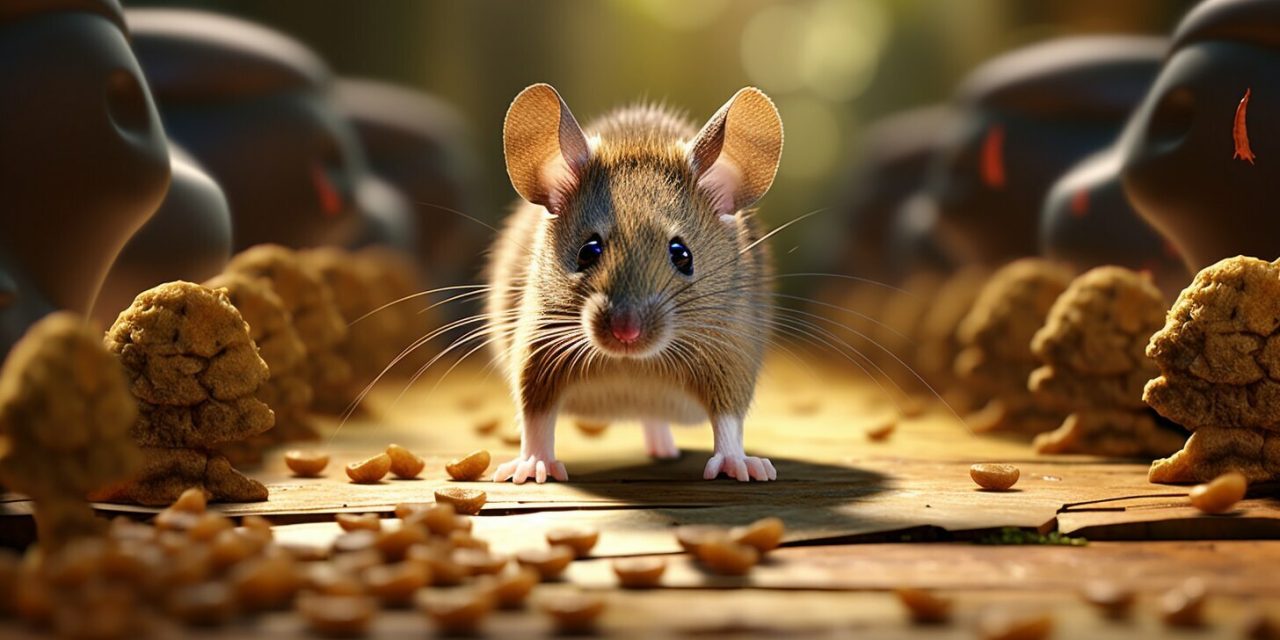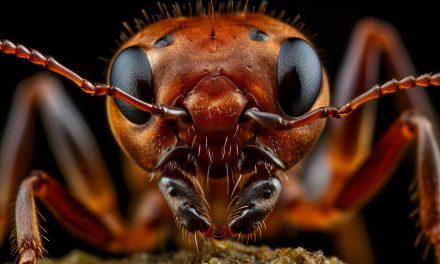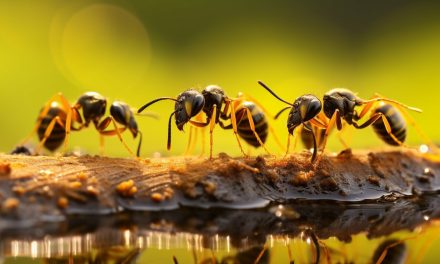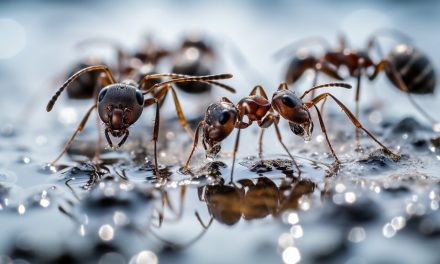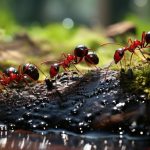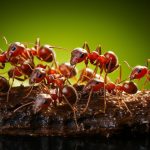This post may contain affiliate links.
Have you ever wondered if mice eat ants? Well, the answer might surprise you. Mice do indeed consume ants, along with a wide variety of other insects. In fact, ants are just one item on their menu!
In the wild, mice have a diverse diet that consists of grains, seeds, and small insects. They are opportunistic feeders, always on the lookout for their next meal. This means that if mice find their way into your home, they will happily make a feast out of any available crumbs, including ants.
However, it’s important to note that pet mice have different dietary requirements compared to their wild counterparts. They should be fed a formulated mix specifically designed for rodents to ensure they receive all the necessary nutrients.
When using food as bait to catch mice, it’s not uncommon for ants and other insects to also be attracted to it. This can make addressing both ant and mouse problems a bit challenging. But fear not! There are steps you can take to tackle these issues.
To address both ant and mouse problems, it’s essential to seal any possible entry points to your home. This will prevent mice from gaining access and ants from marching in. Keeping your living space clean and free of food sources will also discourage these unwanted guests. And, of course, using traps strategically can help reduce both mouse and ant populations.
Key Takeaways:
- Mice do eat ants, along with other insects.
- In the wild, mice primarily consume grains, seeds, and small insects.
- Pet mice should be fed a formulated mix for rodents.
- When using food as bait to catch mice, ants and other insects may also be attracted.
- To address mouse and ant problems, seal entry points, clean up food sources, and use traps.
Understanding the Natural Diet of Mice
When exploring the question of whether mice eat ants, it’s crucial to first understand their natural diet. In the wild, mice have a varied palate that includes grains, seeds, and small insects. These tiny creatures are quite opportunistic when it comes to food, and ants are no exception. While not their primary source of sustenance, mice do consume ants along with a wide variety of other insects.
“Mice primarily eat grains, seeds, and small insects, while ants serve as part of their diverse diet.”
If you happen to have pet mice, it’s important to note that they have slightly different dietary requirements. To ensure their health and vitality, it is recommended to feed them a formulated mix specifically designed for rodents. This mix typically contains a balanced combination of grains, seeds, and other essential nutrients that pet mice need to thrive.
It’s worth mentioning that when mice find their way into a home, they become resourceful scavengers. They will not hesitate to nibble on any available crumbs or food sources. As a result, if you use food as bait to catch mice, it is common for ants and other insects to also be attracted to it. This can inadvertently exacerbate an ant problem alongside the mouse infestation.
| Key Points: |
|---|
| Mice primarily eat grains, seeds, and small insects in the wild. |
| Pet mice should be fed a formulated mix for rodents. |
| Using food as bait to catch mice can also attract ants and other insects. |
Feeding Guidelines for Pet Mice
When it comes to feeding pet mice, it’s important to provide a balanced and nutritious diet. While mice in the wild have a varied diet that includes ants and other insects, pet mice have slightly different dietary requirements. A formulated mix for rodents is the recommended option for their daily meals.
This specially designed mouse food typically consists of a mixture of grains, seeds, and pellets that provide the necessary nutrients for their well-being. It is important to follow the feeding instructions on the packaging to ensure they receive the right amount of food each day.
In addition to their staple diet, you can also supplement their meals with small amounts of fresh fruits and vegetables. These can include items like apples, carrots, and leafy greens. However, be sure to introduce new foods gradually, as sudden changes to their diet can upset their digestive system.
Feeding Tips for Pet Mice
- Remove any uneaten food from the previous day to prevent spoilage and the attraction of insects.
- Provide fresh water in a sipper bottle or shallow dish, ensuring it is changed daily.
- Monitor your mouse’s weight to ensure they are not becoming overweight or underweight.
- Avoid feeding your pet mouse sugary or fatty foods, as these can lead to health problems.
By following these feeding guidelines, you can help ensure that your pet mouse stays healthy and happy. Remember, a nutritious diet is just one aspect of caring for your furry friend. Providing them with a clean and comfortable living environment, regular exercise, and mental stimulation are also crucial for their overall well-being.
Now that you have a better understanding of the recommended diet for pet mice, you can provide them with the proper nutrition they need to thrive.
Mouse Behavior towards Ants
When it comes to mouse behavior towards ants, there are a few key factors to consider. Mice are known to be opportunistic eaters, and this includes consuming ants. In fact, ants are often seen as prey for mice due to their small size and abundance. However, it is important to note that not all mice exhibit the same behavior towards ants.
According to studies and observations, some mice may actively hunt and consume ants as part of their natural predatory behavior. These mice view ants as a potential food source and may exhibit increased interest and aggression towards them. On the other hand, there are mice that may not show as much interest in ants, preferring other food sources such as grains and seeds.
It is worth mentioning that when using food as bait to catch mice, it is common for ants and other insects to be attracted to it. This is because mice and ants share similar preferences when it comes to food. So, if you’re dealing with a mouse problem, it’s important to be aware that using food as bait may lead to an increase in ant activity as well.
The Relationship between Mice and Ants
The relationship between mice and ants can vary. In some cases, they may coexist peacefully, with mice taking advantage of the ants’ resources without causing conflict. However, there are instances where conflicts may arise. For example, if a mouse colony invades an ant nest, the ants may defend their territory, leading to clashes between the two species.
In summary, mice do eat ants as part of their natural diet, but not all mice exhibit the same behavior towards ants. It is important to address both mouse and ant problems by sealing entry points, cleaning up food sources, and using traps to reduce populations. By taking these measures, you can minimize the attraction of both mice and ants and create a more harmonious living environment.
| Mice and Ants: Key Points |
|---|
| Mice are opportunistic eaters and may consume ants as part of their natural diet. |
| Not all mice show the same behavior towards ants, with some actively hunting and consuming them while others may show less interest. |
| Using food as bait to catch mice may also attract ants and other insects. |
| In some cases, mice and ants can coexist peacefully, but conflicts may arise if mouse colonies invade ant nests. |
| To address mouse and ant problems, it is important to seal entry points, clean up food sources, and use traps to reduce populations. |
Mice as Predators of Ants
Mice are known for their diverse diet, which includes consuming ants. In the wild, mice primarily feed on grains, seeds, and small insects, including ants. This natural behavior carries over to pet mice as well. While pet mice should be fed a formulated mix for rodents to ensure they receive a balanced diet, it is not uncommon for them to consume ants if they come across them.
When dealing with a mouse infestation, it is essential to consider their feeding habits. If mice find their way into a home, they will eat any available food sources, including crumbs. Interestingly, when using food as bait to catch mice, it often attracts ants and other insects as well. This is because the scent and presence of food can attract multiple pests.
To effectively address both ant and mouse problems, it is crucial to take preventative measures. Start by sealing any entry points that may allow mice or ants to enter your home. This includes cracks in walls, gaps under doors, or openings around utility lines. Additionally, maintaining a clean environment and promptly cleaning up any food crumbs or spills will help minimize the attraction for both pests.
| Preventive Measures for Mouse and Ant Problems |
|---|
| Seal all entry points in your home to prevent mice and ants from entering. |
| Clean up food crumbs and spills immediately to eliminate food sources for pests. |
| Use traps to catch mice and reduce their populations. |
| Consider professional pest control services if the infestation persists. |
By implementing these preventive measures, you can effectively manage both mice and ant problems in your home. Remember, while mice may view ants as prey, it is essential to address the root causes of the infestation to ensure long-term pest control.
Ant Consumption by Mice
One intriguing aspect of mice’s dietary preferences is their consumption of ants. While mice primarily eat grains, seeds, and small insects in the wild, they have been known to actively hunt and consume ants as part of their natural predatory behavior.
Studies and observations have provided direct evidence of mice consuming ants, indicating that they play a role in their diet. The availability of ants in their environment and their presence as potential prey may influence their consumption patterns. Mice’s agility and ability to catch and consume small insects make ants an attractive food source for them.
When using food as bait to catch mice, it is not uncommon for ants and other insects to also be attracted to it. This is because mice have a keen sense of smell and can detect even the smallest food particles. If you’re dealing with both ant and mouse problems, it’s important to address the root causes. Sealing entry points, such as cracks and holes, will prevent mice from entering your home. Additionally, cleaning up food sources, such as crumbs or spills, will make your environment less attractive to both mice and ants.
Mice and Ants: Coexistence and Conflict
When it comes to mice and ants, their relationship can vary from coexistence to conflict. In some cases, mice and ants can peacefully share the same habitat, while in others, conflicts may arise due to competition for resources.
In terms of coexistence, both mice and ants are often attracted to similar food sources. Mice have a keen sense of smell and can easily detect crumbs or leftover food, which can also attract ants. As a result, it is not uncommon for homes with mice issues to have ant problems as well.
However, conflicts can also occur between mice and ants. Ants are known to defend their territory and food sources, and they may not tolerate mice encroaching on their space. This can lead to confrontations and territorial disputes between the two species.
| Mice and Ants: Coexistence and Conflict | |
|---|---|
| Coexistence | – Mice and ants can peacefully share the same habitat. |
| Competition | – Both mice and ants are attracted to similar food sources, leading to competition for resources. |
| Conflicts | – Ants may defend their territory and food sources, leading to confrontations with mice. |
In order to address both mice and ant problems, it is important to take proactive measures. Sealing entry points, such as cracks or gaps in walls, can prevent mice and ants from entering your home. Additionally, keeping food sources properly stored and cleaning up crumbs can help eliminate attractants for both pests.
If you are dealing with a mouse infestation, using traps can be an effective method to reduce the population. However, it is important to note that when using food as bait to catch mice, ants and other insects can also be attracted to it. To minimize this attraction, consider using ant baits or traps in conjunction with mouse traps.
Key Takeaways:
- Mice and ants can coexist but may also experience conflicts due to competition for resources.
- Both mice and ants are attracted to similar food sources, which can lead to overlapping infestations.
- To address both mice and ant problems, seal entry points, clean up food sources, and use traps strategically.
Dealing with Mice and Ant Problems
If you’re dealing with mice and ants in your home, it’s important to take steps to address both issues. Mice have particular feeding habits, and they will eat any available food sources, including crumbs and insects like ants. To effectively tackle these problems, consider the following strategies:
- Seal entry points: Mice can squeeze through tiny openings, so make sure to seal any cracks or gaps in your home’s foundation, walls, and windows. Using steel wool or caulk can help keep these unwanted visitors out.
- Clean up food sources: Mice are attracted to food left out in the open. Keep your kitchen and dining areas clean and free from crumbs. Store food in airtight containers and regularly empty trash cans to limit their access to food.
- Use traps: Trapping mice can be an effective method of control. There are various types of traps available, such as snap traps or humane catch-and-release traps. Place them in areas where mice are likely to travel, along walls or near food sources.
Remember, when using food as bait to catch mice, it is common for ants and other insects to be attracted to it. Monitoring and managing both pests simultaneously can help ensure an effective and thorough approach.
Preventing Ant Attraction
While dealing with mice, it’s also crucial to take measures to minimize ant attraction. Here are some additional tips to consider:
- Keep your countertops clean and free from food debris. Wipe up spills promptly and sanitize surfaces regularly.
- Store food properly in sealed containers, including pet food.
- Identify and eliminate ant trails by wiping them away with a mixture of water and vinegar.
By following these strategies and maintaining a clean and tidy environment, you can proactively address both mice and ant problems in your home. If the infestations persist, it is advisable to consult a professional pest control service to ensure effective and long-term eradication.
Avoiding a Repeat Scenario
After successfully dealing with mice and ants, it’s crucial to take preventive measures to avoid a recurrence of the problem. Regularly inspect your home for any potential entry points and seal them promptly. Maintain cleanliness, enforce proper food storage practices, and promptly address any signs of infestation.
| Preventive Measures: | Benefits: |
|---|---|
| Sealing entry points | Prevents mice and ants from entering your home |
| Regular cleaning | Eliminates food sources and discourages pests |
| Prompt action | Prevents infestations from worsening and becoming harder to control |
Mice and Ants: Feeding Habits and Interactions
When it comes to feeding habits, mice are opportunistic omnivores. They have a varied diet that includes grains, seeds, and small insects, such as ants. In the wild, mice will readily consume ants as part of their natural foraging behavior.
If you have pet mice, it’s important to provide them with a well-balanced diet. A formulated mix for rodents is recommended to ensure they receive all the essential nutrients they need. While ants can be a part of a wild mouse’s diet, it is not necessary to feed them to pet mice, as the formulated mix will provide them with all the necessary nutrition.
It’s worth noting that when mice find their way into a home, they will scavenge for food and eat any available crumbs. This can inadvertently attract ants and other insects to the same food source. So, while mice may not actively seek out ants as prey in a domestic setting, they can still indirectly interact with them due to their feeding habits.
To address both ant and mouse problems in your home, prevention is key. Sealing any potential entry points that mice can use to access your house, such as cracks or gaps, will help keep them out. Additionally, practicing good sanitation by promptly cleaning up food sources and maintaining a tidy environment will discourage mice from settling in. If an infestation occurs, using traps specifically designed for mice can help reduce their populations effectively.
| Mice Feeding Habits: | Mouse Behavior towards Ants: |
|---|---|
|
|
Conclusion
In conclusion, mice do eat ants, along with a variety of other insects. Their natural diet in the wild consists of grains, seeds, and small insects. However, pet mice should be fed a formulated mix specifically designed for rodents to ensure they receive the proper nutrition.
If mice find their way into your home, they will not hesitate to consume any available crumbs or food sources. It is not uncommon for ants and other insects to be attracted to food used as bait to catch mice.
To effectively address both ant and mouse problems, it is crucial to take preventative measures such as sealing entry points and regularly cleaning up food sources. Additionally, using traps can help reduce mouse populations. By implementing these strategies, you can minimize the presence of mice and ants in your surroundings.
Are Ants a Source of Food for Mice?
Ants are known for their ability to scavenge food, but can ants eat chocolate? While ants have a diverse diet, they primarily feed on sweet substances, such as sugary liquids and fruits. Chocolate, with its rich flavor, does not appear to be a preferred food for ants. However, they are opportunistic eaters, so it is possible that ants may nibble on chocolate if other food sources are scarce. Mice, on the other hand, are creatures with broader dietary choices, and they can eat a wide range of foods, including chocolate. However, it is important to note that chocolate can be harmful to mice in large quantities, causing digestive issues or even toxicity due to theobromine content. Therefore, although both ants and mice may have some interactions with chocolate, it is not a significant or preferred source of food for ants, and it should be consumed with caution by mice.
What is the Impact of Killing the Queen Ant on the Population of Ants?
Killing the queen ant consequences can be devastating for the entire ant population. As the main reproductive individual, the queen is responsible for laying eggs and ensuring the survival of the colony. Without her, there is no offspring production, leading to a rapid decline in the ant numbers. This disruption can even cause the colony to collapse, affecting the ecosystem and potentially disrupting the balance of other species that depend on ants for various interactions such as pollination or soil aeration.
FAQ
Q: Do mice eat ants?
A: Yes, mice do eat ants, along with a wide variety of other insects.
Q: What do mice primarily eat in the wild?
A: In the wild, mice primarily eat grains, seeds, and small insects.
Q: What should I feed my pet mice?
A: Pet mice should be fed a formulated mix for rodents, specifically designed to meet their nutritional needs.
Q: Why do ants get attracted to food bait used to catch mice?
A: When using food as bait to catch mice, it is common for ants and other insects to also be attracted to it.
Q: How can I address both ant and mouse problems?
A: To address both ant and mouse problems, it is important to seal entry points, clean up food sources, and use traps to reduce populations.

